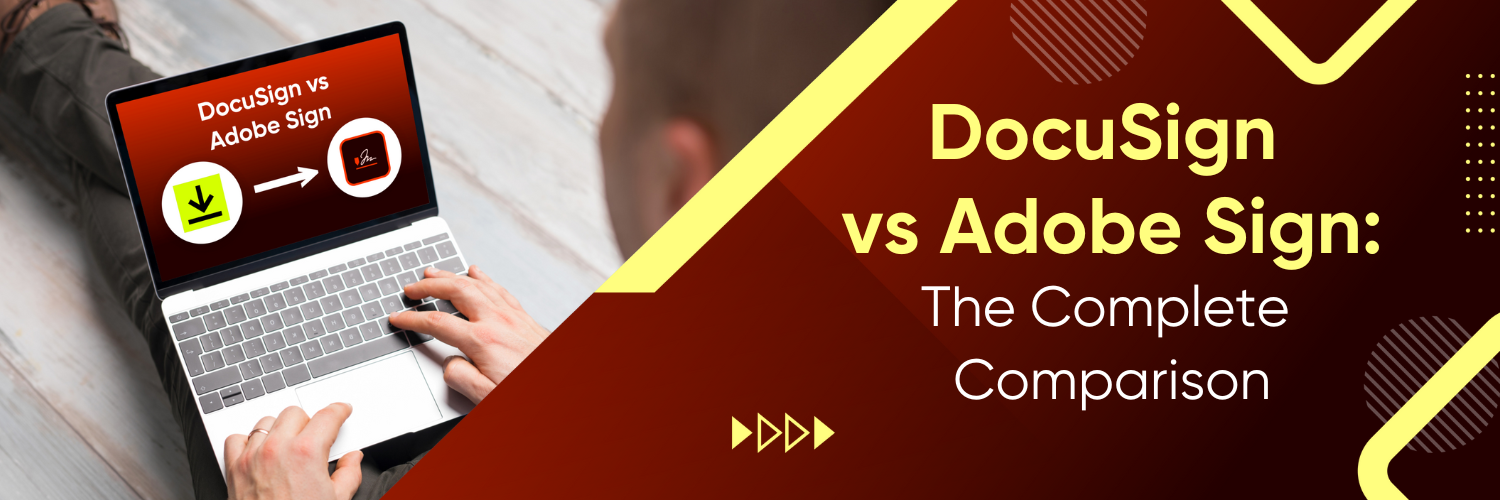Electronic signature tools have changed how businesses sign documents. Instead of using paper, they use digital methods. This makes things faster, saves time, and makes it more secure. These tools let people sign documents online, so there’s no need for printing, scanning, or mailing.
Choosing the right electronic signature tool is important for businesses. It helps them work better and follow the law. Things like how easy it is to use, how secure it is, and how well it works with other software are important. This comparison of DocuSign and Adobe Sign will help businesses pick the best one for them.
DocuSign vs Adobe Sign: Features
User Interface and Ease of Use
DocuSign has a simple interface that guides users through signing documents step by step. It’s easy to understand what you need to do, which makes the signing process smooth and clear.
Adobe Sign is part of the Adobe family, so its design is familiar to users of other Adobe products like Acrobat or Creative Cloud. If you’re used to Adobe’s style, you’ll find Adobe Sign’s interface intuitive and easy to use for signing documents.
Security and Compliance
DocuSign and Adobe Sign both focus on keeping your documents safe. They use encryption to protect your data when it’s sent and stored. They also track every step of the signing process to make sure nothing gets changed without your knowledge. To make sure the right people are signing, they offer options like email verification and two-factor authentication. Plus, they follow laws like the ESIGN Act and GDPR to keep your information private and secure.
Integration capabilities
Both DocuSign and Adobe Sign can work with lots of other business apps, like cloud storage, CRM, and document management tools.
But if you’re already using a lot of Adobe software, you might find Adobe Sign easier to use because it fits in really well with Adobe’s other products.
Mobile functionality
Both DocuSign and Adobe Sign have mobile apps for phones and tablets. You can use them on iOS and Android, making it easy to sign documents no matter where you are.
Customization and branding options
Both DocuSign and Adobe Sign let businesses customize their branding when signing documents. You can add logos, colors, and messages. But DocuSign goes further with more options for custom branding, so you can make the signing process fit your needs perfectly.
Customer support and training resources
Both DocuSign and Adobe Sign prioritize customer support and training resources to enhance users’ experience with their electronic signature platforms.
Unique Features of DocuSign:
- Extensive documentation including guides, FAQs, and how-to articles
- Training videos and webinars for visual and interactive learning
- Dedicated customer success managers for personalized guidance and support
Unique Features of Adobe Sign:
- Tutorials and troubleshooting guides for independent issue resolution
- Knowledge base with information and tips
- User communities for connecting, sharing experiences, and seeking assistance.
Shared Features of DocuSign and Adobe Sign:
- Customer support and training resources
- Empower users to navigate the platform effectively
- Provide assistance in resolving common issues
- Foster user communities for knowledge sharing and collaboration
DocuSign vs Adobe Sign: Pros and Cons
DocuSign Pros:
- Well-known for its user-friendly interface.
- Extensive customization options for branding.
- Advanced features for document customization and workflow automation.
- Strong integration capabilities with various business applications.
- Robust security measures and compliance with legal regulations.
DocuSign Cons:
- Pricing may be higher compared to some alternatives.
- Mobile app functionality could be more intuitive.
Adobe Sign Pros:
- Seamless integration with other Adobe products.
- Familiar interface for users of Adobe software.
- Solid mobile app experience.
- Comprehensive security features and compliance with regulations.
- Offers digital certificate-based authentication for added security.
Adobe Sign Cons:
- Customization options are not as extensive as DocuSign.
- Some users may find the interface less intuitive if they’re not already using Adobe products.
DocuSign vs Adobe Sign: Pricing
Pricing models and plans
DocuSign and Adobe Sign offer flexible pricing models and plans to cater to the diverse needs of their users. The pricing plans typically vary based on factors such as the number of users, document volumes, and included features. It is crucial to evaluate your organization’s requirements and compare the pricing plans of both platforms to identify the most cost-effective option.
Here is a comparison of the pricing plans available for DocuSign and Adobe Sign:
DocuSign pricing plans:
- Personal: $10 per month
- Standard: $25 per month
- Business Pro: $40 per month
- Advanced Solutions: Contact sales for pricing
- Real Estate: Contact sales for pricing
- API Plans: Contact sales for pricing
Adobe Sign pricing plans:
- Acrobat Standard: US$12.99/mo
- Acrobar Pro: US$19.99/mo
Note: that pricing may vary depending on your location and any current promotions or discounts. It is recommended to visit the official websites of DocuSign and Adobe Sign for the most up-to-date pricing information.
DocuSign vs Adobe Sign: Customer Reviews
Docusign
Pros
- “Docusign is easy to use, even on mobile. I use it for creating documents and guiding clients through the process over the phone.” – Ashley H. (Trustpilot, February 2024)
- “Reliable and well working, never experienced any issues or problems.” – Patrick (Trustpilot, January 2024)
- “We’ve been using Docusign since lockdown as letting agents. It saves us over 80 sheets of paper for each new tenant’s move-in pack. It’s really easy to use and has made our lives much easier! We were hesitant at first, but now we wish we had switched to digital sooner.” -Lou R. (Trustpilot, September 2023)
Cons
- “I’ve used Docusign for years, switching from free to paid. It’s great overall, but canceling or downgrading on mobile is tricky. Managed it on desktop. Needs better cross-platform UX.” – Rob (Trustpilot, September 2023)
- “Canceling my subscription is really hard. Customer support links don’t work, so I can’t get help or a refund. Docusign needs to improve.” – Mark T. (Trustpilot, April 2024)
AdobeSign
Pros
- “This platform was easy to set up and much more reliable than what we used before. It has lots of useful features.” – Anonymous (Capterra reviews)
- “Great powerful product, portable as it’s cloud-based, and maintains Adobe’s quality standard.” – Anonymous (Capterra reviews)
Cons
- “Customer service was only through chat, which made solving complex issues challenging.” – Anonymous (Capterra reviews)
- “You can’t edit a file after sending it. If you notice a mistake, you can’t fix it.” – Anonymous (Capterra reviews)
Key Takeaways
Both DocuSign and Adobe Sign offer strong electronic signature solutions.
DocuSign is user-friendly and highly customizable, while Adobe Sign integrates well with Adobe’s ecosystem and prioritizes security.
Deciding which platform gives you the best bang for your buck depends on what your organization needs and how you use it. Look at what features each platform offers, how many users and documents you’ll have, and how much support they provide. Think about your budget and what’s most important for your organization, like how well they integrate with your other tools. That way, you can pick the platform that gives you the most value for your money.
If you want to learn more about electronic signatures or digital marketing, subscribe to our blogs!
FAQs
Q: Are there any significant variations in pricing between DocuSign and Adobe Sign?
Yes, there are differences in pricing models and plans. Both platforms offer various plans based on features, usage limits, and user types. It’s essential to compare the specific pricing details of each platform to determine the best fit for your organization’s needs and budget.
Q: Which platform offers better integration capabilities?
Both DocuSign and Adobe Sign offer robust integration capabilities with popular business applications. However, Adobe Sign’s tight integration with other Adobe products, such as Acrobat and Creative Cloud, can be advantageous for users already relying on Adobe software in their workflows.
Q: How do DocuSign and Adobe Sign prioritize security and compliance?
Both platforms prioritize security and comply with industry standards. They employ encryption technology, tamper-proof audit trails, and authentication methods to ensure document integrity and prevent unauthorized access. DocuSign and Adobe Sign also adhere to legal regulations, such as the ESIGN Act and GDPR.
Q: Can I customize the branding and appearance of documents with DocuSign and Adobe Sign?
Both platforms offer customization options to match your branding needs. You can add logos, colors, and personalized messages to the signing process. However, DocuSign provides more advanced customization features, allowing for custom branding experiences and tailored signing processes.
Q: Can I use DocuSign or Adobe Sign in specific industries like real estate or healthcare?
Yes, both platforms are widely used across various industries. They offer features and integrations that cater to specific industry needs. For example, in real estate, both platforms streamline the signing of lease agreements and purchase contracts. In healthcare, they facilitate patient consent forms and HIPAA-compliant document signing.
Q: Are there any limitations or additional fees associated with using DocuSign or Adobe Sign?
It’s important to review the pricing details and terms of each platform to understand any limitations or additional fees. These can include charges for exceeding document limits, fees for premium support, or fees for additional features or add-ons.













